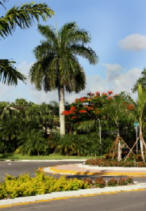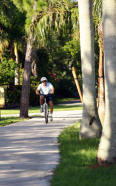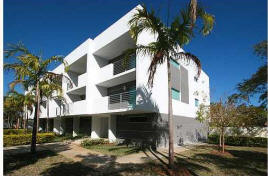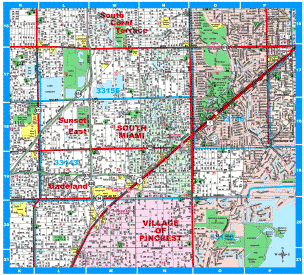About the City of South Miami Florida
The City
of South Miami, approximately 3 miles south of the City
of Miami, encompasses 2.5-square miles within Miami-Dade
County. It borders the University of Miami’s main campus
and the cities of Coral Gables and Pinecrest. U.S.
Highway 1 (South Dixie Highway) carries tens of
thousands of vehicles through the city on a daily basis.
South Miami, incorporated in 1927, is one of the
County's oldest municipalities with a permanent
residential, tri-ethnic population of approximately
10,500. The “town center” area east of US1 is a vibrant
shopping, dining and entertainment venue with a hometown
ambiance. Two major hospitals within the city provide
employment and services to people throughout the county
and beyond.


History of the City of South Miami
Although
Native Americans had doubtlessly roamed the area for
centuries, the recorded history of South Miami began at
the turn of the century when the rich farmlands of South
Dade lured pioneers down through Little Hunting Ground
(later known as Coconut Grove) to Big Hunting Ground
(now known as Cutler).
An early
land owner of the area, W.A. Larkins owned property west
of Red Road and Sunset Drive. He built the first grocery
store in the area, and as the community grew, a post
office was placed in the community. Larkins became the
first Postmaster, and the community took the name of "Larkins".
A depot was placed along the Florida East Coast Railway.
In 1926,
area residents wanted to incorporate their area, and
because of the booming city to the north of them, they
chose the name of "South Miami". The original town
boundaries were Red Road on the east, Kendall Drive to
the south, Palmetto Road to the west (now Palmetto
Expressway), and Bird Road to the north. The year 1926
also saw the first incoming class of freshmen at the
newly chartered University of Miami campus, which abuts
the city of South Miami eastern boundary along Red Road
(SW 57th Avenue). Also founded with a university theme
that same year was the Cambridge Lawns neighborhood of
South Miami, situated just 0.7 miles (1.1 km) from the
university campus. The neighborhood's Cambridge Lawns
Historic District, some 30 homes in the Tudor Revival
and Mediterranean revival style completed in 1928, were
granted historic recognition by the City of South Miami
in 2005.
In 1933,
the original six square miles of South Miami were
reduced to just over three miles (5 km) due to an effort
to reduce municipal responsibilities. The city's size
was reduced again in 1937, and many of the northern city
residents sued to get out of the city. This is why the
city of South Miami has the most irregular boundaries of
any city in Miami-Dade County today.
The Great
Hurricane of September 1926 dealt a punishing blow to
the Town of South Miami. Only the courage and
determination of its citizens permitted the Town to
survive the disaster. Although the Town requested
federal assistance, asking Congress to "relieve the
people of their income tax for the current year", none
was received. To make matters worse, the Florida East
Coast Railway station burned down, leaving the town
without a station for many years. South Miami is a small
municipality of approximately two square miles in
Miami-Dade County, Florida, tucked between the vastness
of Kendall and the confines of Coral Gables. Once known
as “Larkins,” one of the earliest settlements in the
county, the community generates a feeling of permanence.
The city of South Miami has grown from a small farming
community to a vibrant suburb with quiet neighborhoods
and a popular shopping and restaurant district.
As of the
census[1] of 2000, there were 10,741 people, 4,301
households, and 2,593 families residing in the city. The
population density was 1,811.0/km˛ (4,680.5/mi˛). There
were 4,457 housing units at an average density of
751.5/km˛ (1,942.2/mi˛). The racial makeup of the city
was 69.84% White (38.9% were Non-Hispanic Whites,)[5]
24.70% African American, 0.14% Native American, 0.40%
Asian, 0.04% Pacific Islander, 1.75% from other races,
and 2.13% from two or more races. Hispanic or Latino of
any race were 34.37% of the population.
There
were 4,301 households out of which 26.1% had children
under the age of 18 living with them, 40.4% were married
couples living
 together,
15.2% had a female householder with no husband present,
and 39.7% were non-families. 30.7% of all households
were made up of individuals and 9.0% had someone living
alone who was 65 years of age or older. The average
household size was 2.47 and the average family size was
3.15. In the city the
population was spread out with 22.7% under the age of
18, 8.2% from 18 to 24, 31.8% from 25 to 44, 23.7% from
45 to 64, and 13.6% who were 65 years of age or older.
The median age was 37 years. For every 100 females there
were 92.8 males. For every 100 females age 18 and over,
there were 90.4 males.
together,
15.2% had a female householder with no husband present,
and 39.7% were non-families. 30.7% of all households
were made up of individuals and 9.0% had someone living
alone who was 65 years of age or older. The average
household size was 2.47 and the average family size was
3.15. In the city the
population was spread out with 22.7% under the age of
18, 8.2% from 18 to 24, 31.8% from 25 to 44, 23.7% from
45 to 64, and 13.6% who were 65 years of age or older.
The median age was 37 years. For every 100 females there
were 92.8 males. For every 100 females age 18 and over,
there were 90.4 males.
The
median income for a household in the city was $42,488,
and the median income for a family was $57,791. Males
had a median income of $37,250 versus $29,772 for
females. The per capita income for the city was $24,526.
About 8.9% of families and 17.1% of the population were
below the poverty line, including 22.0% of those under
age 18 and 13.4% of those age 65 or over. As of 2000,
speakers of English as a first language accounted for
59.69% of residents, while Spanish speakers consisted of
37.45%, and speakers of French as the mother tongue made
up 1.25% of the population.
Demographics Geographic and Census Data for South Miami,
Florida
The
geographic coordinates of South Miami, a city in
Miami-Dade County in the Miami-Fort Lauderdale metro
area, are Latitude: 25.707°N Longitude: -80.293°W The
City is in the Eastern Standard time zone and has a
sub-tropical climate.
Total Area: 2.30 square miles
Population: 10,741 people (2000 census*)
Caucasian: 38.9% Latino: 34.4% African descent: 24.7%
Asian descent: 1.4%
11,355 (2003 estimated population)
Median age for residents: 37.4 years (this is older than
average age in the U.S.)
Families (non-single residences): 60.3% of the
population
Median household income: $42,488 (higher than National
median income of $41,994)
Form of Government: City Manager/ Commission
Form of Government: City Manager/ Commission
South Miami Condos Real Estate is a hidden treasure within
South Florida

South Miami Departments
Office of the City Manager
Building
City Clerk
Code Enforcement
Finance
Human Resources
Parks & Recreation
Planning & Zoning
Police
Public Works & Engineering
City of South Miami Florida Services
Public Safety
Code Enforcement
Building Permits
Zoning Applications
Adult Recreation Programs
Youth Recreation Programs
The After School House
Passports & Photos
Notary Public
Fingerprinting
Background Checks
Photocopies & Laminating
Voter Registration
Occupational Licenses
Vendor Registration
Schools in South Miami and Vicinity
Miami-Dade County Public Schools
Public K-12 Schools in or near South Miami
Private K-12 Schools in or near South Miami
Miami-Dade Community College
Florida International University
University of Miami
Miami-Dade County Library System
About the South Miami Branch Library
Locate Schools or Libraries



 together,
15.2% had a female householder with no husband present,
and 39.7% were non-families. 30.7% of all households
were made up of individuals and 9.0% had someone living
alone who was 65 years of age or older. The average
household size was 2.47 and the average family size was
3.15. In the city the
population was spread out with 22.7% under the age of
18, 8.2% from 18 to 24, 31.8% from 25 to 44, 23.7% from
45 to 64, and 13.6% who were 65 years of age or older.
The median age was 37 years. For every 100 females there
were 92.8 males. For every 100 females age 18 and over,
there were 90.4 males.
together,
15.2% had a female householder with no husband present,
and 39.7% were non-families. 30.7% of all households
were made up of individuals and 9.0% had someone living
alone who was 65 years of age or older. The average
household size was 2.47 and the average family size was
3.15. In the city the
population was spread out with 22.7% under the age of
18, 8.2% from 18 to 24, 31.8% from 25 to 44, 23.7% from
45 to 64, and 13.6% who were 65 years of age or older.
The median age was 37 years. For every 100 females there
were 92.8 males. For every 100 females age 18 and over,
there were 90.4 males. 